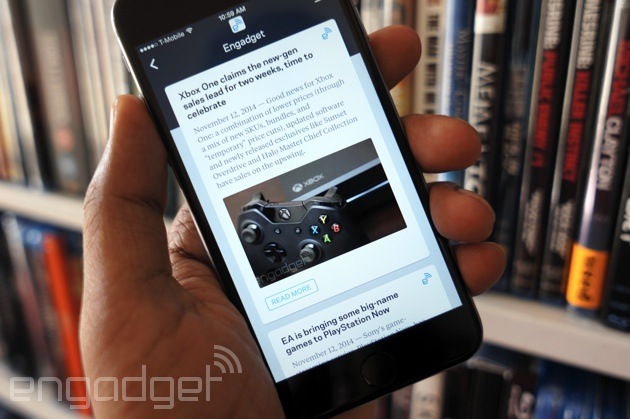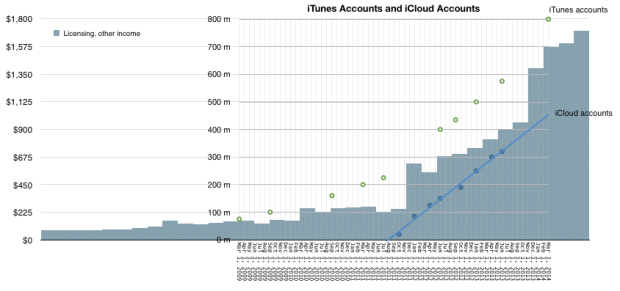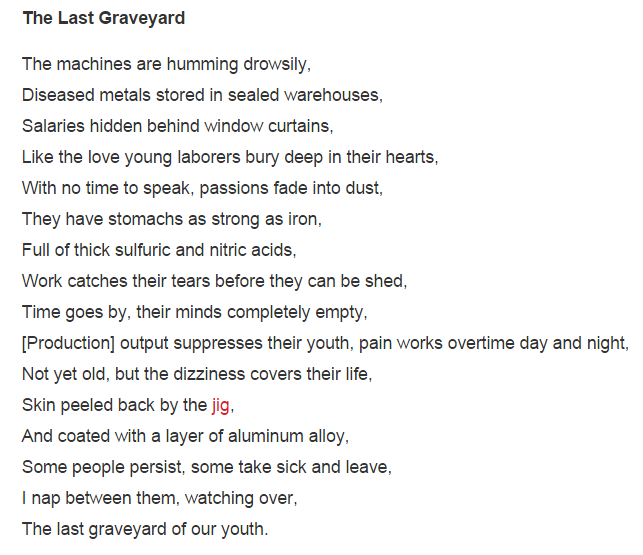Sections
Pick of the Week – Nokia
Nokia took most in the tech world by surprise announcing a new $250 Android tablet called the N1, which they’re aiming to launch in China and Russia. It’s the same size as the iPad Mini and has a similar unibody aluminium construction. It seems to be a direct competitor for the Nexus 9 tablet if anything. From a software perspective the main talking point is the interactive and minimalist Z launcher running on top of Lollipop:
“The N1 runs Android 5.0 out of the box, but Nokia has painted over Lollipop with its own homebrew Z Launcher — a little project the company has grown strangely fond of. The launcher quietly keeps tabs on the apps and actions you rely on most frequently, and once you use them enough, they’ll slowly bubble to the top of a list that lives on your home screen. No widgets, no cruft; just your most-used bits where you can get to them easily.”

Nokia have also made Z launcher available for free for other Android devices on Google Play. It’s somewhat of an acquired taste dispensing with widgets and screens in favour of free-form handwriting recognition input:
The Nokia N1 is manufactured by Foxconn in a relationship that goes much further than a normal ODM deal with Nokia’s contribution essentially limited to just design and branding:
“Foxconn rather interestingly will handle distribution and sales and customer care, and will even be responsible for liabilities and warranty costs.”
The arrangement leaves the door open to an intriguing possibility. Namely that Nokia built upon the setup to launch an Android M powered phone with Z launcher on January 1st 2016 when their Microsoft deal over smartphones expires.
In a further strange twist it turns out that while Nokia are additionally planning to sub-licence the iconic Nokia brand to other OEMs, Microsoft are continuing to dismantle their connection to it with the announcement of a deal to replace the Nokia App Store with Opera Store across S40, Symbian, Asha and Nokia X devices.
Smartphones and Manufacturers
- This Guardian article lifts the lid on the onerous terms imposed by Apple on GT Advanced Technologies for supply of sapphire glass for iPhone displays. Quality, yield, exclusivity were all part of the picture it seems and contributed to the eventual failure of the deal bankruptcy of the supplier. It should serve as a cautionary tale for anyone vying to get into Apple’s supplier list:
“The reality is that Apple, as the most valuable company on Earth by market capitalisation, now has the power to make or break a company through its supplier relationships.”
- Samsung need to look beyond smartphones for the next big growth opportunity. The Internet of Things seems a natural fit for a company that manufactures such a wide range of consumer goods. Their biggest issue is a lack of end to end connected systems software excellence covering both devices, services and data science. They seem to be taking some concrete steps to reorganise engineering capability to address the IoT. It’s unclear whether simply moving some handset software engineering skills over will make the difference though:
“the company is transferring about 500 engineers from its mobile-phone division and allocating them largely to the Internet initiative, according to people familiar with the matter.”
- The Mobile Overview Report is released quarterly based on “internal data sources averaging over 500 million hits per month” from scientamobile.com. The latest Q3 2014 report underscores the primacy of Apple products globally in key regions:
Google and Android
- ArsTechnica’s review of Android Lollipop is both comprehensive and packed with useful information and screenshots. Dozens of areas of new and updated functionality are reviewed. The review serves to underline the size and scope of the changes in the “biggest ever” Android platform update. Summarising their key takeaways from an end user perspective:
- Material Design: Google have introduced a new non-skeuomorphic design language based on a paper/card paradigm with an emphasis on bolder colours and fluid animation. It will work across all Android verticals including Auto, Wear and TV.
- Notifications: Numerous changes to support the “notification as interface” paradigm.
- Multiuser support: Multiple users will potentially be able to log into a Lollipop based device. A new Guest user mode will be introduced.
- Google app suite: Gmail, Calendar, Play + other existing properties refreshed and updated. Inbox + Messenger introduced.
- New Camera interface: Camera 2 provides access to RAW images and imaging pipeline.
- Tap & Go: Restores apps, data & Google Accounts from other Android devices.

- Included in the ArsTechnica review is a graphic which provides a revealing illustration of how much of the new functionality lies in Google’s GMS layer and not within AOSP:
Android Lollipop strips Android naked even more to protect against unlicensed Chinadroids http://t.co/uZp7FmbI3S #ym pic.twitter.com/sWDx96Dk7U
— Andreas Constantinou (@andreascon) November 14, 2014
- The Verge were full of praise for the trusted places feature which is part of Lollipop’s Smart Lock which is not included in the highlights list above. It allows your Android device to be unlocked depending on location and is a good example of a “found feature” happily discovered by this user during real world usage. It’s also apparently in GMS and not AOSP:


- A TechCrunch post from an ex-Googler provided some genuine insight into the mystery of why Google released TWO email clients in the form of Inbox and Gmail5. Essentially it’s a reflection of their engineering-led cultural approach to product management which stands in contrast to the more traditional top down direction you might find in companies like Apple:
“All of the decisions revolved around the central fact that a typical Gmail user was receiving only about five emails per day, most of which were of promotional nature, and as such, required no response. This was in contrast to a typical Googler who received an average of about 450 emails per day, many of which were important to at least read, with a good chunk of them requiring a reply.”
- Hiroshi Lockheimer, Google VP Engineering, helps contextualise Google’s Android strategy in this Business Insider interview providing insights such as this one on Material Design:
“One of the things we do at Google in general, but also at the Android team, is iterate. Focusing on the user interface has been an area we knew we wanted to iterate on for a long time. We did the first major UI overhaul with Gingerbread and Honeycomb back in those days and we’ve been planning for something like Material Design since then. It took a while to get the designs right. We wanted to perfect it.”

- Despite all the praise and positivity, it’s inevitable there will be teething problems for early adopters particularly those brave souls undertaking to update to L on the Nexus 7. Many of them were reporting issues with the Lollipop update this week with some regretting not waiting before updating.
- AnandTech have a deeper dive into the ART runtime which replaces Dalvik in Lollipop. It’s a platform feature that many users will be entirely unaware of but it will bring performance and energy management improvements:
“The big paradigm-shift that ART brings, is that instead of being a Just-in-Time (JIT) compiler, it now compiles application code Ahead-of-Time (AOT). The runtime goes from having to compile from bytecode to native code each time you run an application, to having it to do it only once, and any subsequent execution from that point forward is done from the existing compiled native code.”
Apps and Services
- Facebook today remains arguably the most dominant communication platform ever created:
“A decade after Facebook emerged from the Ivy League dorms in which it started, it is the most powerful information gatekeeper the world has ever known. It is only slightly hyperbolic to say that Facebook is like all the broadcast-television networks put together.”
- However, this Atlantic article suggests the company faces severe challenges to retain that dominance in a future where users are increasingly suspicious of its motives. Two clear threats are “apps that take advantage of physical proximity” such as Yik Yak and messaging platforms such as Secret and Whisper that address growing user security and privacy concerns.

- Perhaps inevitably, Facebook appear to be exploring an Enterprise angle exploiting their current popularity to build-in a level of corporate indispensability with a Facebook at Work product.
- A key Enterprise concern is security. Interestingly one of the first new features added to Whatsapp since their acquisition by Facebook is end to end encryption along the lines of Silent Circle’s Silent Text. The software enablers for the feature seem to have come via Open Whisper Systems:
“the company won’t be able to decrypt messages on its own, even if they receive requests from law enforcement. It’s a step above the chat encryption Google and Facebook offer, which they could possibly decrypt. WhatsApp tapped Open Whisper Systems, developer of the secure called app Signal and TextSecure, to implement the encryption.”
- Wildcard have another take on the “Notification as interface” pattern. They’ve launched a web browser “that deconstructs mobile sites into cards that are easy to digest on your phone”. Engadget thought the overall effect was one at times akin to a “fancy RSS reader”.

- Twitter have built a service that indexes “every tweet ever”. This Twitter engineering blog post provides more detail of the Hadoop based pipeline used to build “a search service that efficiently indexes roughly half a trillion documents and serves queries with an average latency of under 100ms.“
- The New Yorker profile Spotify CEO Daniel Ek. Spotify is a company seemingly on the up with a rapidly growing user base and increasingly accepted business model built around subscription-based streaming music. However, it’s questionable to some whether it is good or bad for artists and the paradigm shift to streaming feels like one that will still take years to play out and involve much friction along the way considering the service USP is essentially “frictionless musical moments”:

- A more immediate direct threat to Spotify is Apple’s plan to roll out the Beats streaming music service for free to all iPhones and iPads in the New Year.

Asia
- Quartz ran a fascinating wide-ranging interview with Hugo Barra of Xiaomi about Mi, their Indian subsidiary. In it he lays out the playbook for how to develop a modern smartphone identifying core strategic activity and areas for outsourcing to an ODM:
“We will, for sure, write software here. We certainly are also considering the possibility of manufacturing through partners. We don’t make products ourselves. We use Foxconn and others to do the manufacturing for us. We are here for the long run and it might make a lot of sense to be able to make [devices] here.”
- He also highlights the importance of effective partnership with key ecosystem propositions that can be used to build an overall more compelling product. For instance Barra reveals that Mi phones will replace the standard Android dialler with Truecaller:
“Truecaller, for instance, is a great example of a company that is not an Indian company but has done really well in India. They have built a whole dialer app. The dialer is a special kind of app. Nobody will let them replace the native dialer with their product. We are going to partner with them and integrate their dialer directly into our dialer. The result would be a native dialer that is much smarter and much more interesting that what is commonly found.”
- Foxconn would doubtless prefer the spotlight stayed on their growing partnerships with the likes of Xiaomi and Nokia. However, working conditions remain a concern that won’t go away. The emergence of some very bleak poetry written by a Foxconn worker who later went on to commit suicide are a grim reminder of that:
Cloud Computing
- Amazon’s post-profit business model hasn’t much success in the stock market in 2014 leading some to wonder whether Amazon should spin off its expensive and growing AWS business to concentrate on retail:
“spinning off AWS would bolster the bottom line of Amazon’s remaining and much bigger core retail business, and theoretically support a higher valuation for it, too.”

- It seems inevitable in the longer-term as Amazon’s capacity to invest in supporting future cloud platform growth is significantly lower than that of its primary competitors Google and Microsoft. It probably won’t happen while Jeff Bezos is running Amazon though.
- @asymco commenting on iCloud makes a clear connection between iTunes and iCloud account numbers and bottom line revenue in Apple’s “Licensing, other income” reporting category. According to his analysis, Apple are heading towards 500m iCloud users:

Big Data and Machine Learning
- The OpenWorm project has led to the neural network of a simple worm being implemented in software and Lego. When initiated the system seems to exhibit the predicted sorts of emergent behaviour suggesting “that the ghost in the machine is just the machine“:
“The nematode worm Caenorhabditis elegans (C. elegans) is tiny and only has 302 neurons. These have been completely mapped and the OpenWorm project is working to build a complete simulation of the worm in software. … The key point is that there was no programming or learning involved to create the behaviors. The connectome of the worm was mapped and implemented as a software system and the behaviors emerge.”
Smart Retail
- Panasonic’s personalised signage could be a harbinger for Minority Report style future involving digital spam that chases you around the shopping mall. It should serve as a reminder of the over-notification antipattern:

- If the signs don’t get you the music will courtesy of Shazam‘s partnership with Adspace Networks:
“The company says that the partnership will make use of its ‘ultrasonic watermark’ technology to be able to recognize ads up to 40 feet away. The technology is active regardless of whether a commercial is being displayed on a screen or not – simply being in the vicinity of a screen should be enough.”
- Showrooming is “the phenomenon of looking at items at a brick-and-mortar store whilst simultaneously checking the prices available online.” We’ve probably all done it at some point but it’s still a relatively niche activity in the West. Showrooming is pretty mainstream in Asia though:

Wearables and the Internet of Things
- Engadget went hands on with the Intel Mica smart bracelet which they thought had more style than substance. TNW also previewed the product and highlighted a number of unique features such as a VIP contacts list and personalised notifications that overall suggest it is well worth further examination:
“The device will also act as a “personal concierge” to help locate recommended restaurants, shops and other businesses or alert you to Google Calender events and when to leave to arrive on time. MICA only sends notifications as vibrations, not sound, to stay more discreet.”

- Hackaday question whether the Internet of Things can really be built around existing radio technology when “GSM will never be low power or cheap, WiFi will never be low power enough, and Bluetooth will never have the range.” They suggest that we may need a new long-range low power radio technology such as Microchip’s LoRa:
“At Electronica last week, Microchip demoed their IoT solution, the LoRa. This module has a 15km (rural) or ~3km (heavy urban) range, works for a year on two AAA batteries, and is very cheap. Bandwidth? That’s crap, but you’re not streaming videos to your shoe.”

- The ESP8266 module provides a sub-$5 WiFi capability to an Arduino Uno thereby bringing down the cost of a WiFi enabled Arduino concept such as this WiFi enabled temperature logger to below $15:


Open Source and Programming
- Interesting inside perspective from a Linaro contributor of what it means to work upstream with an open source community. There’s a nice analogy made between open source and a communal garden with the community operating as gardeners with the interests of the garden as their primary concern rather than external entities seeking to gain from it:
“The opensource could be seen as a big public garden, where everyone can plant flowers. The people in the garden, being there a long time, know what kind of flowers you can plant without interacting badly with the existing flowers in the garden and where you can plant them. If the people in the garden like your flowers, they can point you to a place where you can put the flowers and also they may help you to do this if they want. Those people expect you to take care of your flowers after you have planted them and as they helped you to plant the flowers, they also expect you to help in return. If a group of people is not willing to follow the rules of the public garden and just want to plant flowers because they have to (e.g. because their boss put a ticket office near the south entrance of the garden and they want the public garden to be more attractive from there), the key keepers of the garden will just come and close the gates to those people.”
- InfoQ interviewed an iOS developer who has opted to exclusively use Swift for his next product and feels it has been the right decision. Mainly it seems because of the language’s support for functional programming concepts such as immutability and currying which are key concerns for his line of development (database visualisation).
- The edX Introduction to Linux MOOC has garnered 300k signups since August. It’s the largest number of registrations for any of their courses and a good indicator of the importance of and interest in Linux.
- Android development support is now available in Visual Studio 2015 Preview. There are three development options supported: C++, Cordova and C#. All three options come with integrated Visual Studio Android emulator target. It’s yet another remarkable milestone in Microsoft’s recent moves to embrace cross-platform and open source under the leadership of new CEO Satya Nadella.


- RelativeWave have a paid Interaction Design prototyping app called Form. They’ve just been acquired by Google and their app has been given away for free. Presumably Google will be directing the acqui-hired team to work on an Android version:
“If doodling on a napkin is a 1 and actually coding the app is a 10, building a prototype with Form is somewhere around a 6.”
- SourceLair provide an interesting looking “code in your browser” proposition with seemingly comprehensive in-browser support for Python/Django, Ruby, Node, HTML5, git and JIRA integration. All with a nice-looking IntelliJ style look and feel. The target seems to be hobbyist or experimental developers that don’t want to spend time building their own development environment in a host PC or VM.

Science
- In the growing struggle between jellyfish and humans, it seems the jellyfish are winning with some help from us. Human structures in the sea from oil platforms and ships hulls to floating rubbish are all being colonised by jellyfish polyps allowing them to increase the frequency and intensity of blooms.

- Contracting Ebola doesn’t necessarily mean a death sentence. There’s growing evidence that the key to survival is continuously sipping several litres of fluid a day.
- Exoplanet science has advanced enormously in the last couple of decades and it seems distinctly plausible that in time we will encounter the unmistakable signature of life in the analysis of exoplanetary spectra. That could lead to an existential crisis for some world religions that are entirely earth-bound in their concerns. What would it mean to our understanding of our place in the universe to find signs of life elsewhere in the galaxy?
“With the discovery in a distant planet’s light spectrum of a chemical that could only be produced by living creatures, humankind will have the opportunity to read a new page in the book of knowledge. We will no longer be speculating about whether other beings exist in the universe. We will know that we not alone.”
- Hollywood exoplanet adventure Interstellar offers its own challenge to earth-bound concerns managing to combine human interest with esoteric topics such as gravitational time dilation and multiple dimensions. One unforgettable scene on the ice-bound Dr Mann’s planet offers one of the bleakest perspectives on humanity ever committed to celluloid without needing any aliens to make its point:

Work and Culture
- From the Telegraph, this blistering must-read call to arms for “Generation Brand” provides a new take on the “never trust anyone over 30” meme. It rails against a gerontocracy in which wealth is trickling up to the older generation with a boom in cruises and holidays for the elderly while the younger generation are sliding into intergenerational debt and disenfranchising themselves by not voting:
“You need to get involved and you need to vote. This is the only way politics will reflect your views and needs. And you need to do this now because the demographics are stacked against you. Every year there are more and more old people. If you don’t change things soon, the status quo that serves you so poorly and them so well will be locked in for a generation.”
- Apparently “purse-lipped opinions outcompete generous ones” through a psychological mechanism called hypercriticism. If such negativity bias wasn’t bad enough, there’s further bad news which depressingly suggests there may actually be an advantage to being mean rather than kind because:
“When we hear negative statements, we think they’re inherently more intelligent than positive ones.”
- The more complex your job the more likely you are to score higher on memory tests and general cognitive skills:
“the strongest predictor of cognitive abilities at age 70 is intellect earlier in life … The stronger the cognitive starting point, the more brain reserve people might have as the normal processes of aging start to erode some nerve connections involved in higher order thinking. Having a complex job that requires constant activation of these neural networks, and formation of new connections, can also contribute to building this reserve capacity.”
- Interesting and insightful perspective on work and business in Japan:
“The slice of contemporary Japanese life of keenest interest to you is dominated by one particular relationship: that of the Japanese salaryman to his employer. If you understand this relationship, it is almost a Rosetta stone. You’ll immediately be able to predict true things about the world like “Japanese startups probably have huge difficulties in hiring.””
- This VentureBeat article finds much to criticise in the Lean Startup movement. Concerns are raised around deprioritisation of architecture over MVP, long-term viability and retaining a product versus feature sensibility.

